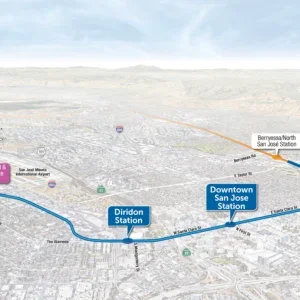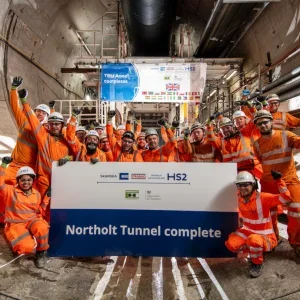On 4 September in Turkey, Italian contractor Astaldi broke through the second tube of the US$234M Bolu tunnel on the Ankara-Istanbul highway.
The occasion was marked by a ceremony involving the Turkish Prime Minister and the Italian ambassador to Turkey. The other 3km long tube was holed through one month earlier on 28 July.
Earlier attempts to drive the tunnels had run into difficulties with clayey ground shortly after excavation began in 1993 and were finally abandoned altogether when a 350m stretch of tunnel collapsed in 1999 due to the Duzce earthquake.
The original design for the tunnels featured five support classes for excavation areas ranging from 190m2 to 260m2. A design review was carried out to analyse the seismic loads induced by the earthquake. To cross active faults, an articulated lining design was chosen, in preference to over-excavation with a filled double lining, as the most appropriate for the tunnels’ cross sectional area.
The geology consists of highly tectonised and intermixed mudstones, siltstones and limestones with stiff clay. Driven at a separation of 50m, drill and blast was used for a 400m section of the tunnel, but deteoriating ground conditions saw the balance being excavated by means of a CAT excavator equipped with a Krupp hydraulic hammer. CAT loaders were used to muck out to Astra trucks. Mesh, steel fibre reinforced shotcrete and Atlas Copco’s MAI self-drilling anchor bolts have all been used for support.
The excavation sequence saw a 7m high top heading being opened under a 30 strong array of 6m long forepoles. This allowed installation of three parts of the five section steel arches that were set at 1.1m intervals. Twenty 12m long MAI anchors were then drilled and grouted in place using an Atlas Copco Boomer drillrig. A 400mm thick layer of steel fibre shotcrete was applied, followed by a temporary invert before the bench was advanced at the sides to allow the installation of the arch legs, plus further bolts and shotcrete. After this, the invert was excavated across the full width of the heading and filled with concrete surrounding two steel reinforcement cages. Invert concrete was kept within 25m of the face and the final concrete lining was poured in-situ using self-propelled formwork within 75-85m of the face. With excavation areas as high as 275m2, the final section is only 100m2.
Following the breakthrough, there are some outstanding lining, concreting and waterproofing works to be carried out in both tubes. On 19 September bids were received for the mechanical and electrical installations. Completion is due by December 2006, when the time to cross the Bolu pass will drop from 30 to 5 minutes.







